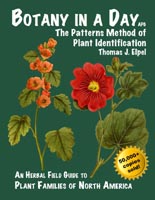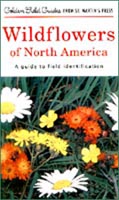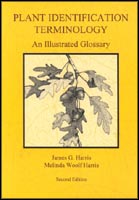|
Granny's Country Store > Wildflowers & Edibles > Plant Identification Resources | Search | View Cart
An Easier Way to Identify Plants
by Thomas J. Elpel
The study of botany is the study of patterns in plants. Related plants have similar characteristics, and botanists have placed them in groups according to these patterns of similarity. In essence, botanists have created a filing system where all plants with one pattern are placed in one file folder, all the plants with another pattern are placed in another folder, and so forth. The better you can recognize these patterns, the better you will be able to identify plants.
Unfortunately, very few people know about these patterns when they start identifying plants. Most people pick up a book of color photos and flip through hundreds of pages of pictures hoping to find a match. When they finally find a possible match, then they may not know the specific parts well enough to determine if they have the correct answer or something totally unrelated that looks superficially similar.
On the other hand, many people take college courses and learn to use a flora with a key. This method can require hundreds of hours of training to memorize all the botanical terms. The tedium of the process can stifle the enthusiasm of even the most enthusiastic nature-lovers. Ironically, to become proficient with a botanical key ultimately requires at least some knowledge of plant classification, and therefore plant patterns. Yet, these patterns are often presented almost as an after-thought, if at all.




|
Botany in a Day: The Patterns Method of Plant Identification presents a more holistic approach to learning about plants that starts with an overview of the botanical filing system. Learn how and why the filing system is organized the way it is, and learn to recognize the patterns among related plants. Botany in a Day shows how related plants have similar characteristics for identification and often similar uses. It takes you from the top down through the plant kingdom to plant families, but it does not include a key below the family level.
When you know these basic patterns, then you will recognize something about a new plant, even before you know its individual name. In many cases, you will only need to identify the family pattern to know the edible and medicinal properties of your plant specimen.
Most of the key patterns presented in Botany in a Day can be observed with the naked eye, assuming you have normal vision. However, some of the smaller flowers will require the use of a botanical loupe or lens (also known as a geology loupe, jeweler's loupe, or diamond loupe). You may also need a loupe for observing minute flower parts when identifying individual species within a family.
It is much easier to identify the proper genus or species of a plant after you have accurately identified the proper family. Use Botany in a Day to find the correct family, then you can use color picture books to help narrow down choices. Just be sure to use a wildflower guide that is organized by families. Those that are organized by habitats or colors of the flowers will ultimately hinder your progress.
My favorite companion guide to Botany in a Day is the Golden Guide to Wildflowers of North America: A Guide to Field Identification (Temporarily Out-of-Print). Use Botany in a Day to determine the proper family, then you can turn to that family in the Golden Guide and flip through a few pages to find a match. I use other local picture books as well (pictured farther down the page) but I've been constantly amazed wherever I go to find the flowers I am looking for included in this little book.
With the Golden Guide I can usually find the correct genus, and sometimes it is possible to pin down the exact species. If I need the species information, and I am not able to determine it from my Golden Guide or any of my other wildflower books, then I finally turn to a local flora with a botanical key. You could start at the beginning of the key, and progress through it to the proper family, genus and finally the species, but it is a lot easier to get to your final answer if you short-cut the process with the aid of Botany in a Day and books like the Golden Guide, then use the local flora to go only from the genus down to the correct species.
Yes, you will need to know the botanical nomenclature to get through the key, but it isn't such a daunting task when going through only a few lines of text. I recommend using the book Plant Identification Terminology: An Illustrated Guide to help you understand the terms in the key. You will find it amazingly easy to key out flowers by using all of these books together, compared to trying to do it using only a botanical key.
|
-Please scroll down the page for the "Add to Order" button.-
|